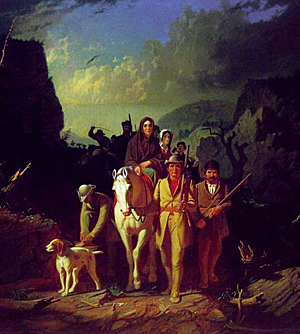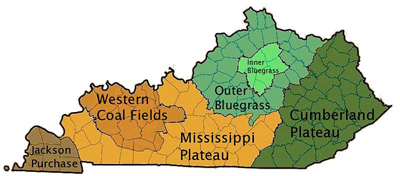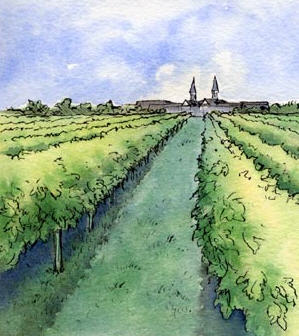

Daniel Boone led settlers to Kentucky, which went on to become the third largest wine producing state in the U.S.
The Kentucky Wine Industry
Soars Once Again
For a state primarily known for its excellent Bourbon whiskey Kentucky has seen a burgeoning wine business. Here’s an APPELLATION AMERICA backgrounder on an up and coming wine state.
by
Tricia Houston
August 30, 2007
It’s a little known fact that the nation’s first commercial vineyard was planted in Nicholasville, Kentucky in 1798 by Jean Jacques Dufour, winemaker for the Marquis de LaFayette. By 1860, Kentucky was the nation’s third largest in the production of wine. Prohibition put an abrupt halt to the State’s winemaking as grapevines were literally ripped from the ground.
Times have changed yet again with the popularity of wine among American consumers. With agribusiness grants and other incentives, the wine industry is once again stimulated, and development of vineyards and wineries in Kentucky is burgeoning. Recent studies show that more than 600 acres of grapes have been planted and 40 plus wineries are now licensed.

The growing regions of Kentucky are divided into six areas of the state with the Ohio River Valley AVA overlapping.deposited eons ago. Kentucky, too, was once covered with an ancient sea, leaving similar generous deposits of limestone, clay and shale. Unfortunately, Kentucky has a continental weather pattern. While the soils may be conducive to grapes, the climate sometimes is not.
Kentucky can be generalized as a series of dissected plateaus and gently rolling plains separated by scarps. Most regions are characterized by erosional landforms on gently dipping Paleozoic elastic or carbonate rocks. The areas where the majority of vineyards have been planted exist in central Kentucky. The region, which takes its name from the lush growth of native bluegrass, consists of The Inner Bluegrass, mostly on the Lexington Limestone, and the Outer Bluegrass, mostly on limestones, dolomites, and shales of Late Ordovician and Silurian age.
A transition zone between these two sub regions, underlain by the Kope and Clays Ferry Formations, is known as the Eden Shale belt. There are several rivers which flow across the Bluegrass Region, most draining into the Ohio River. Even though the area is a mostly flat, the structure of the drainage is evident and consistent.
The other growing area that has seen a surge in viticulture is the Northern Kentucky region. While technically referred to as part of the Outer Bluegrass, Northern Kentucky has topography that is distinctly different than the central region, with high ridges and low valleys, and a greater influence of the Ohio River on microclimates within the region. To a much lesser extent, there are some pockets of grape growers on the far side of the Knobs region toward the Western Coal Fields, most near to the Ohio River delta.
Yet in the past decade, there have been unusual and unexpected weather patterns – perhaps heralding climate change? Several of the past 10 years have seen Kentucky in a moderate to severe drought pattern, including 2007, where an average of 5-6” is needed to relieve the current drought. With thousands of new vines in the ground this spring, growers are forced to hand water, as most growers do not use drip irrigation.
Winters and late spring frosts can do damage to the grapes, and limit the varieties that are planted. This spring brought a devastating spring frost. A week of temperatures in the eighties in early April pushed bud break to occur. This was followed by a period of 5 days when the lows plunged to 19 degrees, giving a loss of 40 percent to 90 percent of the grape crop. The central bluegrass region was hit hardest. Vinifera varieties are already showing crown gall damage due to the freeze. Winter’s variable temperatures can be problematic as well, though the past decade has seen a warming trend, with no real sustained below-zero periods. Still, the growers are warned to bury grafts to limit the winter damage.
While Kaan Kurtural, Kentucky’s Viticulturist, has had only two years on the job, his work at the University of Kentucky’s Agricultural Division has started to reap rewards. The diversity program offered through the state will now assist with the purchase of vines and the establishment of a vineyard. But the fight continues over which varieties to plant. Just over the river in Ripley, Ohio, Kinkead Ridge owner Ron Barrett has been working with growers in Kentucky. Barrett’s farm is exclusively vinifera and Ron has had success with keeping his plants healthy.
But Barrett has years of experience from his days in Oregon; experience Kentucky growers do not have. Kurtural wants to see only French hybrids planted with the exception of Cabernet Franc. He contends that the vinifera will not do well in Kentucky. However, both the growers and the
Jean Ferris Winery is among the two dozen wineries operating in Kentucky today. wineries want the vinifera for the profitability and the ability to make a recognized type of wine. Those who plant vinifera do so without the ability to take part in the cost-share programs, and some have chosen to plant those varieties.
The majority, however, are planting varieties like: Vidal Blanc, Chambourcin, Norton/Cynthiana,
Times have changed yet again with the popularity of wine among American consumers. With agribusiness grants and other incentives, the wine industry is once again stimulated, and development of vineyards and wineries in Kentucky is burgeoning. Recent studies show that more than 600 acres of grapes have been planted and 40 plus wineries are now licensed.
What Makes Kentucky Wine Unique: It Starts with the Soil
The soil structure of Kentucky has been compared to the soils of France. In north-eastern France, a basin of limestone marl that starts in England runs all the way down through the vineyards of Champagne, the Loire Valley and ultimately Burgundy. The best vineyards lie on this ridge, known as the Kimmeridgian . The soil varies from hill to hill, but all contain at least some of this limestone clay, which is heavy with nutrients from the fossils of shellfish
The growing regions of Kentucky are divided into six areas of the state with the Ohio River Valley AVA overlapping.
Kentucky can be generalized as a series of dissected plateaus and gently rolling plains separated by scarps. Most regions are characterized by erosional landforms on gently dipping Paleozoic elastic or carbonate rocks. The areas where the majority of vineyards have been planted exist in central Kentucky. The region, which takes its name from the lush growth of native bluegrass, consists of The Inner Bluegrass, mostly on the Lexington Limestone, and the Outer Bluegrass, mostly on limestones, dolomites, and shales of Late Ordovician and Silurian age.
A transition zone between these two sub regions, underlain by the Kope and Clays Ferry Formations, is known as the Eden Shale belt. There are several rivers which flow across the Bluegrass Region, most draining into the Ohio River. Even though the area is a mostly flat, the structure of the drainage is evident and consistent.
The other growing area that has seen a surge in viticulture is the Northern Kentucky region. While technically referred to as part of the Outer Bluegrass, Northern Kentucky has topography that is distinctly different than the central region, with high ridges and low valleys, and a greater influence of the Ohio River on microclimates within the region. To a much lesser extent, there are some pockets of grape growers on the far side of the Knobs region toward the Western Coal Fields, most near to the Ohio River delta.
And Then There is the Weather to Contend With
Kentucky has a moderate climate, characterized by warm, yet moist conditions. Summers are usually warm, and winters cool. Kentucky's weather patterns are influenced by the Gulf of Mexico, especially during summer. Much of Kentucky's average 46 inches of precipitation a year falls in spring, the rainiest season. From south to north, precipitation decreases. Southern Kentucky receives the highest average precipitation, about 50 inches a year, while the north averages only 40 inches.Yet in the past decade, there have been unusual and unexpected weather patterns – perhaps heralding climate change? Several of the past 10 years have seen Kentucky in a moderate to severe drought pattern, including 2007, where an average of 5-6” is needed to relieve the current drought. With thousands of new vines in the ground this spring, growers are forced to hand water, as most growers do not use drip irrigation.
Winters and late spring frosts can do damage to the grapes, and limit the varieties that are planted. This spring brought a devastating spring frost. A week of temperatures in the eighties in early April pushed bud break to occur. This was followed by a period of 5 days when the lows plunged to 19 degrees, giving a loss of 40 percent to 90 percent of the grape crop. The central bluegrass region was hit hardest. Vinifera varieties are already showing crown gall damage due to the freeze. Winter’s variable temperatures can be problematic as well, though the past decade has seen a warming trend, with no real sustained below-zero periods. Still, the growers are warned to bury grafts to limit the winter damage.
So What Kind of Grapes Can Grow Well in Kentucky?
Though there have been some vineyards and wineries that have been in production for decades, the majority have come on line in the past 5-7 years. The State finally realized the need for a viticulturist and enologist, and in 2005, they were on board. Prior to that, there was little structure when it came to varietal planting. Vineyard owners had virtually no guidance on what varieties to grow, which would make the best wine, or what trellising system to use.While Kaan Kurtural, Kentucky’s Viticulturist, has had only two years on the job, his work at the University of Kentucky’s Agricultural Division has started to reap rewards. The diversity program offered through the state will now assist with the purchase of vines and the establishment of a vineyard. But the fight continues over which varieties to plant. Just over the river in Ripley, Ohio, Kinkead Ridge owner Ron Barrett has been working with growers in Kentucky. Barrett’s farm is exclusively vinifera and Ron has had success with keeping his plants healthy.
But Barrett has years of experience from his days in Oregon; experience Kentucky growers do not have. Kurtural wants to see only French hybrids planted with the exception of Cabernet Franc. He contends that the vinifera will not do well in Kentucky. However, both the growers and the

Jean Ferris Winery is among the two dozen wineries operating in Kentucky today.
The majority, however, are planting varieties like: Vidal Blanc, Chambourcin, Norton/Cynthiana,
 READER FEEDBACK: To post your comments on this story,
click here
READER FEEDBACK: To post your comments on this story,
click here
Print this article | Email this article | More about Kentucky | More from Tricia Houston













